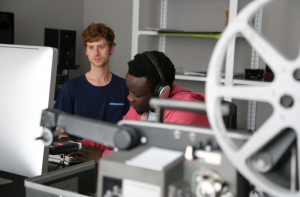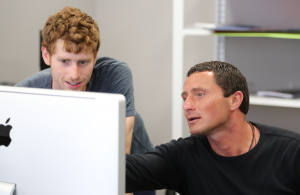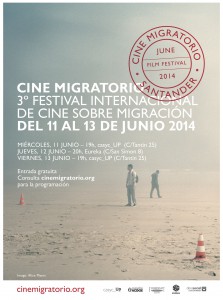 At the beginning of this summer I was furiously preparing for the third Cine Migratorio film festival in Santander, Spain. During my final three months of my Fulbright ETA grant, this film festival consumed me. It was exhausting, challenging, and frustrating at times. But it also gave me a sense of purpose and community that really enriched my experience abroad. Before getting involved, I was mainly focused on teaching Global Classrooms, a Model U.N. program for bilingual high school students, which was, after all, my job. But when the Global Classrooms conferences came to a close in March I had fewer hours of work and found myself eager to start something new. Fortunately, the structure of the Fulbright ETA grant encourages grantees to go beyond their teaching duties and design their own side projects that engage with communities within their school and beyond.
At the beginning of this summer I was furiously preparing for the third Cine Migratorio film festival in Santander, Spain. During my final three months of my Fulbright ETA grant, this film festival consumed me. It was exhausting, challenging, and frustrating at times. But it also gave me a sense of purpose and community that really enriched my experience abroad. Before getting involved, I was mainly focused on teaching Global Classrooms, a Model U.N. program for bilingual high school students, which was, after all, my job. But when the Global Classrooms conferences came to a close in March I had fewer hours of work and found myself eager to start something new. Fortunately, the structure of the Fulbright ETA grant encourages grantees to go beyond their teaching duties and design their own side projects that engage with communities within their school and beyond.
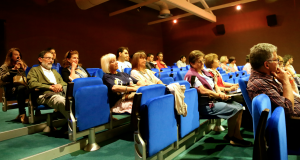 In 2012 Libby Masback, a Fulbright ETA at the time, took on a very ambitious side project with the help of two friends living in Santander – an activist migration-themed film festival. Libby moved to London the year before I arrived in Spain, but she wanted to continue the festival into its third edition with the help of locally based coordinators. Daniel Stern, Yanique Campbell (Fulbright ETA), and myself, all English teachers from the U.S., were eager to collaborate and build upon the foundation that Libby had established in previous years.
In 2012 Libby Masback, a Fulbright ETA at the time, took on a very ambitious side project with the help of two friends living in Santander – an activist migration-themed film festival. Libby moved to London the year before I arrived in Spain, but she wanted to continue the festival into its third edition with the help of locally based coordinators. Daniel Stern, Yanique Campbell (Fulbright ETA), and myself, all English teachers from the U.S., were eager to collaborate and build upon the foundation that Libby had established in previous years.
The festival was right up my alley– it engaged with film and anthropology, two of my primary interests. Furthermore, it specifically addressed migration in Spain, which I had researched as an assistant for the author of Adoptive Migration: Raising Latinos in Spain. Between the years of 2002 to 2007, Spain received the most migrants than any other countries in Europe. From 2000 to 2010 Spain’s foreign-born population increased from 2% of Spain’s population to 12%. The newness of this reality was apparent in Santander– even without my prompting, the topic of migration came up frequently in casual discussions in and outside the classroom, and it was not uncommon to stumble across xenophobic graffiti in the streets. As a Chinese American, questions regarding my race have never featured so centrally and overtly in my daily interactions as they did in Cantabria. Some people referenced the wave of migration as a cause of the economic crisis in Spain, which has left over half of young people in Spain unemployed. However, migrant communities have been hit hard by the crisis: the majority of the 547,980 people who left Spain in 2013 were migrants.
12%. The newness of this reality was apparent in Santander– even without my prompting, the topic of migration came up frequently in casual discussions in and outside the classroom, and it was not uncommon to stumble across xenophobic graffiti in the streets. As a Chinese American, questions regarding my race have never featured so centrally and overtly in my daily interactions as they did in Cantabria. Some people referenced the wave of migration as a cause of the economic crisis in Spain, which has left over half of young people in Spain unemployed. However, migrant communities have been hit hard by the crisis: the majority of the 547,980 people who left Spain in 2013 were migrants.
 I give all of this background to convey the context in which the Cine Migratorio film festival was born. The festival was created as a means of addressing the plethora of circulating questions and anxieties regarding migration, with the critical added element of new voices and international perspectives– specifically, those of migrants. As co-directors of the festival, we wanted to provide a platform for migrant stories from around the world to be told and heard. Importantly, we wanted to include in our selection of films, the stories of migrants in Santander. So we began two simultaneous projects: we solicited migration-themed films from all over the world and we led a video production workshop for migrants in Santander, whose videos would be screened in the film festival.
I give all of this background to convey the context in which the Cine Migratorio film festival was born. The festival was created as a means of addressing the plethora of circulating questions and anxieties regarding migration, with the critical added element of new voices and international perspectives– specifically, those of migrants. As co-directors of the festival, we wanted to provide a platform for migrant stories from around the world to be told and heard. Importantly, we wanted to include in our selection of films, the stories of migrants in Santander. So we began two simultaneous projects: we solicited migration-themed films from all over the world and we led a video production workshop for migrants in Santander, whose videos would be screened in the film festival.
With the help of Cantabria Acoge, an NGO that supports migrants in Santander, we connected with six migrants who wanted to participate in the Taller de Cortometrajes (Short Film Workshop). We were fortunate to be granted access to the space and resources at Casyc, Caja Cantabria Bank’s cultural center, where we met every week from March to June. The participants came from various countries: Ecuador, Equatorial Guinea, Moldova, Peru, Morocco and Bulgaria. Some of them had just arrived a few months earlier, others had been in Spain for fifteen years. Ranging in age from 18 to 45 years old, we formed an unlikely group of friends, brought together through close collaboration over the course of three months.
We started with discussion-based classes, reflecting on the meaning of the words such as «home» and «belonging,» and then brainstorming different visual or sonic representations of these themes. During these introductory courses the participants shared personal stories about their journeys to Spain, their struggles learning Spanish, their experiences of discrimination, and their passions for Spanish culture. Based on these conversations, they picked topics for their films, began to write scripts, and drafted story boards in preparation for shooting. We shot in participants’ homes, on the streets, on the beach, on soccer fields, in parks, and on farms. It was a time for experimentation in which the participants finally saw their ideas taking real form. The resulting films demonstrate the talent and heterogeneity of the group– the variation in content and style suggests a myriad of migrant experiences and the videos personalize the often abstracted topic of migration. Check out the six short films here.
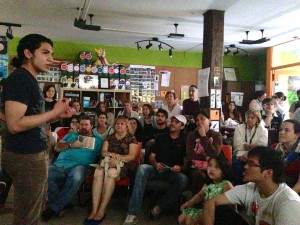 While wrapping up the workshop, we also reviewed international film submissions, curated the programming for the three-day festival, publicized the event, wrote the program, and did interviews with local newspapers. It was a month of many firsts. And it wouldn’t have been possible without the guidance of Libby and her team, the funding of Fulbright, and the support of Cantabria Acoge, Casyc, and Eureka, a community center for the arts. During the final month of preparation I realized just how many individuals were there to help out in every aspect, ranging from coordination and publicity to the revision of written materials. Through this process, I really felt like a part of a local community, supported by a network of invested individuals.
While wrapping up the workshop, we also reviewed international film submissions, curated the programming for the three-day festival, publicized the event, wrote the program, and did interviews with local newspapers. It was a month of many firsts. And it wouldn’t have been possible without the guidance of Libby and her team, the funding of Fulbright, and the support of Cantabria Acoge, Casyc, and Eureka, a community center for the arts. During the final month of preparation I realized just how many individuals were there to help out in every aspect, ranging from coordination and publicity to the revision of written materials. Through this process, I really felt like a part of a local community, supported by a network of invested individuals.
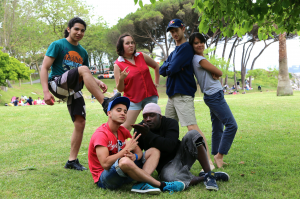 In total we screened 25 movies from 19 different countries, covering the genres of documentary, fiction, animation, and experimental film. The films addressed a variety of topics such as displacement, violence, bureaucracy, separation, racism, and faith. We dedicated one entire night of the festival to the screening of the films made in the workshop, which was by far the most exhilarating event of the festival. The workshop participants presented their films to the audience and offered a Q+A session following the screenings. The venue of Eureka was packed and the audience was full of questions and comments. It was so exciting to see the participants speak confidently as artists and storytellers to a public that was there to listen. Although the participants of the workshop are too often seen as outsiders, foreign to Spain and lacking native skills and knowledge, they showcased their wealth of knowledge during the festival. They are experts on migration, with experiences we can all learn a lot from.
In total we screened 25 movies from 19 different countries, covering the genres of documentary, fiction, animation, and experimental film. The films addressed a variety of topics such as displacement, violence, bureaucracy, separation, racism, and faith. We dedicated one entire night of the festival to the screening of the films made in the workshop, which was by far the most exhilarating event of the festival. The workshop participants presented their films to the audience and offered a Q+A session following the screenings. The venue of Eureka was packed and the audience was full of questions and comments. It was so exciting to see the participants speak confidently as artists and storytellers to a public that was there to listen. Although the participants of the workshop are too often seen as outsiders, foreign to Spain and lacking native skills and knowledge, they showcased their wealth of knowledge during the festival. They are experts on migration, with experiences we can all learn a lot from.
